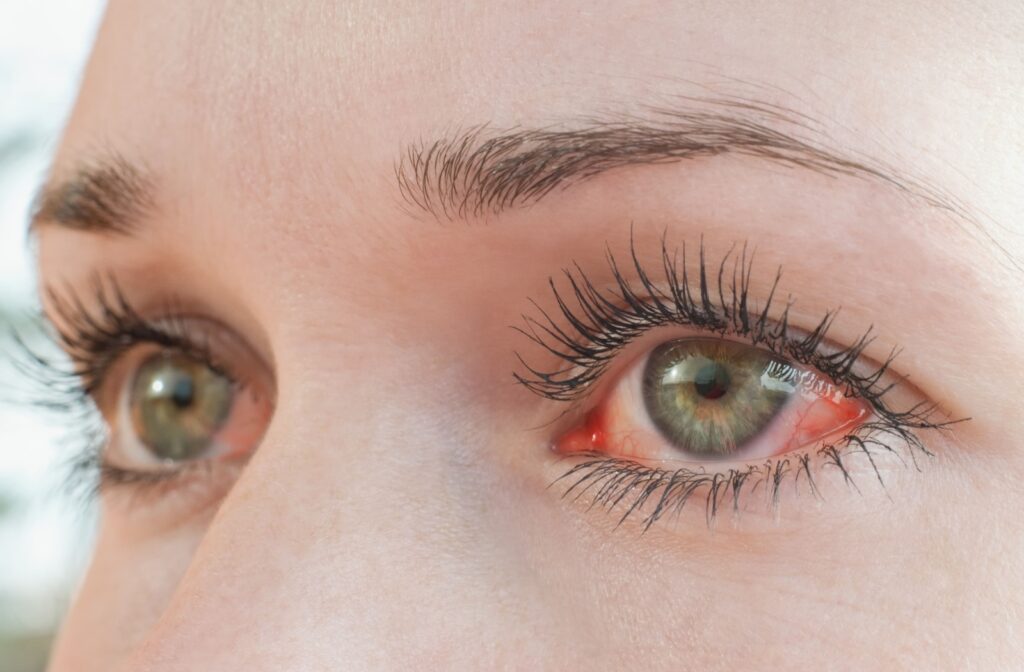Waking up with red, itchy eyes is enough to throw off anyone’s day. In many such cases, we tend to assume that the culprit is pink eye (conjunctivitis).
But here’s the catch: pink eye isn’t always responsible. Some conditions share similar symptoms, making it easy for even the most seasoned Google searcher to draw the wrong conclusion. To prevent misdiagnosis and pinpoint what’s really going on, you need to know which conditions are most often mistaken for pink eye. These include:
- Eye allergies (Allergic conjunctivitis)
- Styes
- Dry eye syndrome
- Blepharitis
- Uveitis
If you’ve been dealing with discomfort for more than a day or two, it’s time to consider whether you might be facing another condition.
What Exactly Is Pink Eye?
Pink eye, medically known as conjunctivitis, happens when the conjunctiva (the thin, transparent layer that covers the whites of the eyes and lining the eyelids) becomes inflamed.
The kind of pink eye most people think of is caused by bacterial or viral infections. While it’s not generally serious, it can be very contagious. Spotting pink eye’s symptoms early is key to finding relief and preventing it from spreading.
Spotting the Symptoms of Pink Eye
Pink eye symptoms can overlap with plenty of other eye issues, which is why it commonly gets misdiagnosed. Common symptoms that help identify pink eye often include:
- Redness in the white of the eye
- Increased tear production
- Itchy or burning sensation in the eye
- Discharge that may cause the eyelids to stick together overnight
- A gritty feeling, like sand in your eye
Although these signs might seem familiar, they don’t automatically implicate pink eye. An accurate diagnosis requires a closer look at the possible causes and distinguishing symptoms of other conditions.
Conditions Often Confused with Pink Eye
Sometimes, issues that seem like pink eye are entirely different conditions that require their own treatments. Here are a few of the most common culprits:
Allergies
Eye allergies can be a bit confusing because, medically speaking, they’re actually a form of conjunctivitis known as allergic conjunctivitis. However, they’re distinct enough from other types of pink eye that they require entirely different treatments. Seasonal allergies or exposure to airborne irritants such as pollen or dust mites are frequent causes.
How It’s Different
Unlike pink eye, eye allergies usually affect both eyes and might be accompanied by other classic allergic symptoms, such as sneezing, nasal congestion, or an itchy nose. Also, while viral and bacterial conjunctivitis are highly contagious, allergies aren’t contagious at all.
Over-the-counter antihistamines paired with lubricating eye drops often help manage symptoms quickly, but for persistent issues, it’s worth consulting your eye doctor.
Styes
A stye occurs when an oil gland at the edge of your eyelid becomes infected and forms a red, painful lump that’s tender to the touch.
How It’s Different
While styes and pink eye may both cause redness, styes are localized to the eyelid and don’t typically result in discharge or widespread redness across the eye. Warm compresses can offer relief, but if a stye doesn’t improve, your optometrist may need to step in.
Dry Eye Syndrome
Ever feel like there’s sandpaper on your eyes? That’s one of the hallmark signs of dry eye syndrome, which happens when your eyes don’t produce enough tears or when your tears evaporate too fast.
How It’s Different
Unlike pink eye, dryness is the primary concern with dry eye syndrome and is rarely accompanied by thick discharge unless there’s another underlying condition in play. Managing dry eye requires consistency, from using artificial tears to adjusting habits that cause eye strain, like extended screen time.
Blepharitis
Blepharitis is an inflammation of the eyelids, often linked to skin conditions like rosacea or dandruff. Along with red or swollen eyelids, you may notice crusty buildup at the base of your eyelashes.
How It’s Different
Blepharitis affects the eyelids more than it does your actual eye. Regular cleaning with a gentle cleanser can help reduce discomfort, though persistent cases benefit from professional guidance to prevent long-term irritation.
Uveitis
This one comes with a more serious warning flag. Uveitis refers to inflammation in the middle layer of your eye (the uvea) and includes symptoms like severe redness, pain, light sensitivity, and blurred vision. It often results from autoimmune issues or infections.
How It’s Different
Unlike pink eye, uveitis is a potentially sight-threatening condition that demands immediate medical attention. If you’re dealing with intense pain or vision changes, skip the home care and call your eye doctor immediately.
When to Get Expert Advice
Self-diagnosis is rarely the best approach when it comes to eye health. While understanding your symptoms and tracking their patterns is helpful, there’s no substitute for a trained optometrist.
If your redness, irritation, or discomfort has lasted several days, has gotten worse, or is accompanied by fever or vision changes, it’s time to act. Eye doctors are equipped to carefully assess your condition, offer a precise diagnosis, and recommend tailored treatments that help you recover faster.
Clarity Starts Here
Your eyes are two of your most important assets. So when something feels off, it’s worth prioritizing your health and getting an accurate diagnosis. Eye symptoms like redness or itchiness might seem straightforward at first glance, but only a professional evaluation can truly separate pink eye from other potentially serious conditions.
At 2020 Eyecare Ohio, we’re here to protect your vision and provide clear answers. When you’re searching for answers, book your appointment, and trust our team to take care of your eyes with expert insight and care.



